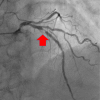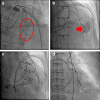Relief of vasospasm with fasudil after off-pump coronary artery bypass grafting: a case study
- PMID: 30051150
- PMCID: PMC6062643
- DOI: 10.1186/s40792-018-0481-9
Relief of vasospasm with fasudil after off-pump coronary artery bypass grafting: a case study
Abstract
Background: Coronary vasospasm after coronary artery bypass grafting (CABG) is a rare but potentially lethal complication. It is often refractory to several vasodilators. We report a case of refractory coronary vasospasm relieved by fasudil injection.
Case presentation: A 74-year-old woman who had three instances of in-stent stenosis at the left anterior descending artery (LAD) was referred for CABG treatment. Preoperative coronary angiography showed 90% in-stent stenosis of the proximal LAD and 75% stenosis of the diagonal branch. We performed a left internal thoracic artery (LITA)-LAD bypass and a right internal thoracic artery (RITA) diagonal branch bypass. After anastomosis, transit time flow measurement revealed poor blood flow of LITA-LAD bypass even after re-anastomosis. We performed coronary angiography and detected a vasospasm in the native coronary arteries, which was not relieved using conventional vasodilators (calcium channel blockers, isosorbide dinitrate, and nicorandil) However, we were able to relieve the coronary vasospasm by administering fasudil (a Rho kinase inhibitor) injection without causing systemic hypotension.
Conclusions: Fasudil may be an important vasodilator, especially in cases of coronary vasospasm after CABG.
Keywords: Coronary artery bypass graft; Coronary artery vasospasm; Fasudil; Rho kinase inhibitor.
Conflict of interest statement
Ethics approval and consent to participate
Not applicable.
Consent for publication
Informed consent was obtained from the patient for the publication of this case report and accompanying images.
Competing interests
The authors declare that they have no competing interests.
Publisher’s Note
Springer Nature remains neutral with regard to jurisdictional claims in published maps and institutional affiliations.
Figures


References
LinkOut - more resources
Full Text Sources
Other Literature Sources

